-
Tomorrow, the 26th (Friday), there is a warning of heavy snow and blizzard, mainly on the Sea of Japan side; there is a risk of more than 50 centimeters of snow in many places.
2025/12/25 21:17
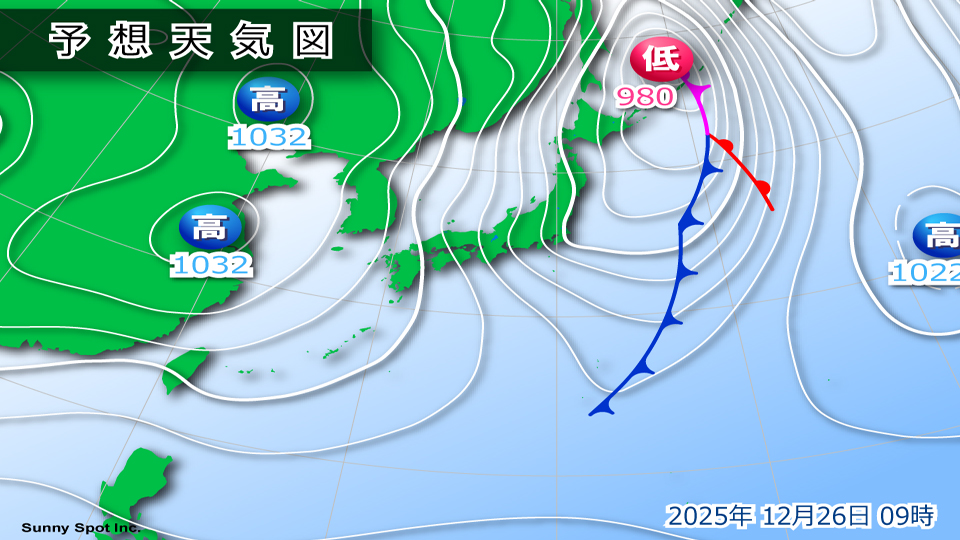
-
Tomorrow, on the 26th, the area around Honshu will have a strong winter-like atmospheric pressure pattern with highs in the west and lows in the east, with extremely cold air in the sky. Near Honshu, the isobar lines are vertically narrow, and winds blow strongly from the north. There is a risk of heavy snow and blizzard widespread from the Sea of Japan side of northern Japan to the Sanin area.
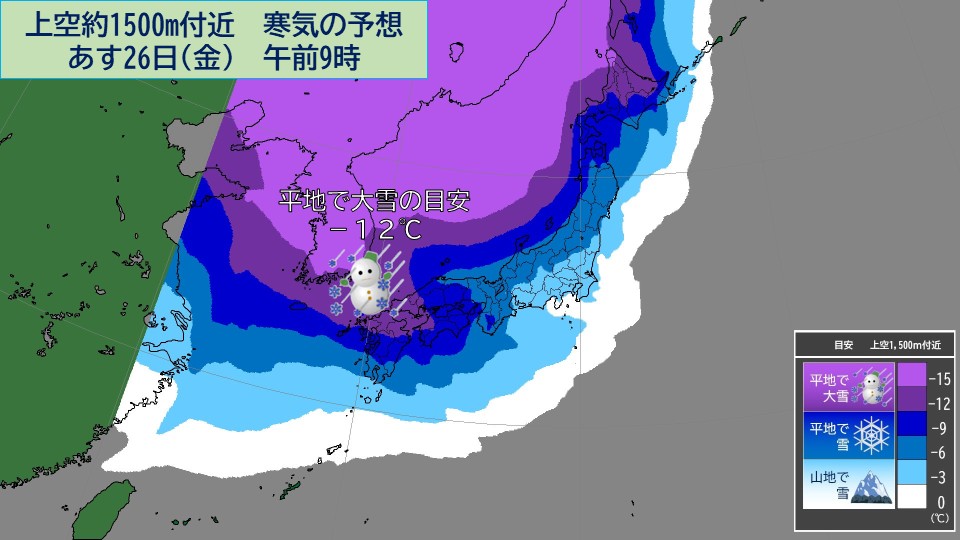
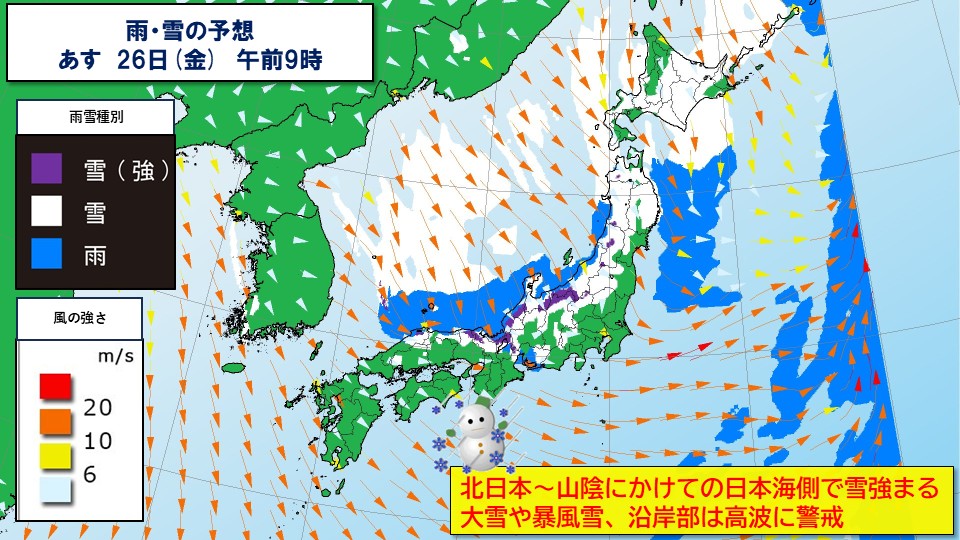
Tomorrow, the 26th (Friday), snow clouds will roll in one after another, especially along the Sea of Japan coast from Hokuriku to northern Kinki and the San'in region, and there is a risk that 24-hour snowfall could reach 50 to 60 cm in many places, especially along the mountains. There will be snowfall even in flat areas, and there will be areas where snowfall will increase rapidly in a short period of time. Snow will fall on the flatlands of northern Kyushu, and there are likely to be some places along the mountains of Tokai and Shikoku where it will snow into the morning.
Also, northerly winds will become stronger, mainly in areas along the Sea of Japan from Hokkaido to the Sanin area, causing blizzards in some places. In the coastal areas from Tohoku to the San'in area, waves are expected to rise and cause heavy swells.
From tomorrow the 26th (Friday) to the 27th (Saturday) the day after, please be on guard for rapid increases in snowfall due to heavy snowfall, traffic disruptions, blizzards and strong winds, and high waves in coastal areas, especially in areas along the Japan Sea side of northern and western Japan. Also, be careful of power outages, fallen trees, and avalanches caused by snow fronts and trees.
The heavy snow coincides with the timing of travel, such as returning home at the end of the year or traveling, so if you are driving, please check the latest traffic information and drive more safely than usual.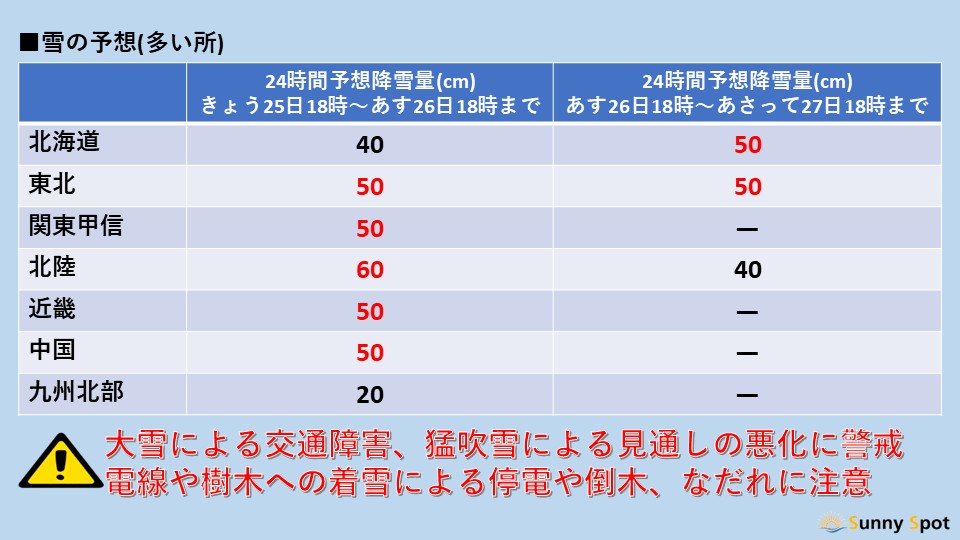

-
[10-day forecast for the year-end and New Year holidays] Will stormy weather coincide with the rush to return home and make U-turns Possibility of snow on the Pacific side early in the new year
2025/12/25 14:52
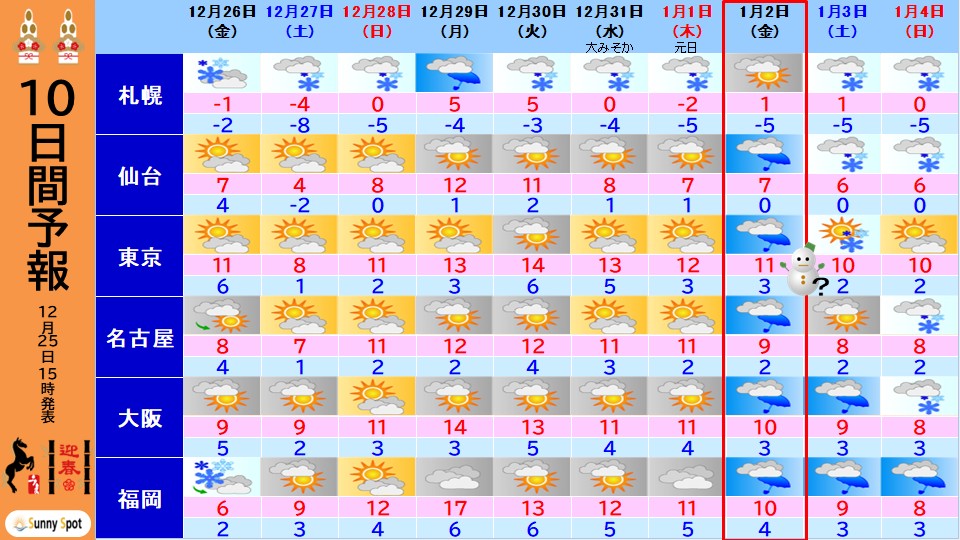
-
# Weather points for 10 days during the year-end and New Year holidays #
+Tonight to Friday the 26th, warning-level heavy snow and strong winds mainly on the Sea of Japan side
+From the end of the year to New Year's Day: Calm weather with high temperatures
+January 2nd (Friday) Low pressure on the south coast, snow in places on the Pacific side
+3rd (Saturday) A low pressure system is rapidly developing and there is a risk of stormy weather
+There is a possibility that the U-turn rush will overlap with the stormy weather
I think that many people will finish work today, the 25th (Friday), and go on their year-end and New Year holidays from tomorrow the 26th (Saturday) to January 4th (Sunday).
Let's take a look at the detailed weather for the next 10 days.
#Tomorrow, the 26th (Friday)#
The winter-like pressure pattern will strengthen, and quite strong cold air will flow into the upper atmosphere in a westerly direction.
Snow clouds are moving not only on the Sea of Japan side but also on the Pacific side,
There are places where it will snow in Hiroshima, Kyoto, Mie, and Iwate prefectures, and snow is expected to accumulate on Mt.
.
From 6 a.m. on Friday the 26th to 6 a.m. on Saturday the 27th, 70 centimeters of snow is expected to fall in many mountainous areas in Tohoku, Hokuriku, and the Tokai region.
Please be careful of traffic disruptions due to heavy snow.
In addition, due to the rapidly developing low pressure system, very strong winds are expected to be accompanied by snow,
which is expected to cause snowstorms in some places.
Please be careful of strong winds that could overturn the truck and poor visibility due to blizzards.
During this year, there is a possibility that the weather will be particularly bad on Friday the 26th,
transportation may be affected, so if you are planning to return home tomorrow, please be aware of the latest traffic information.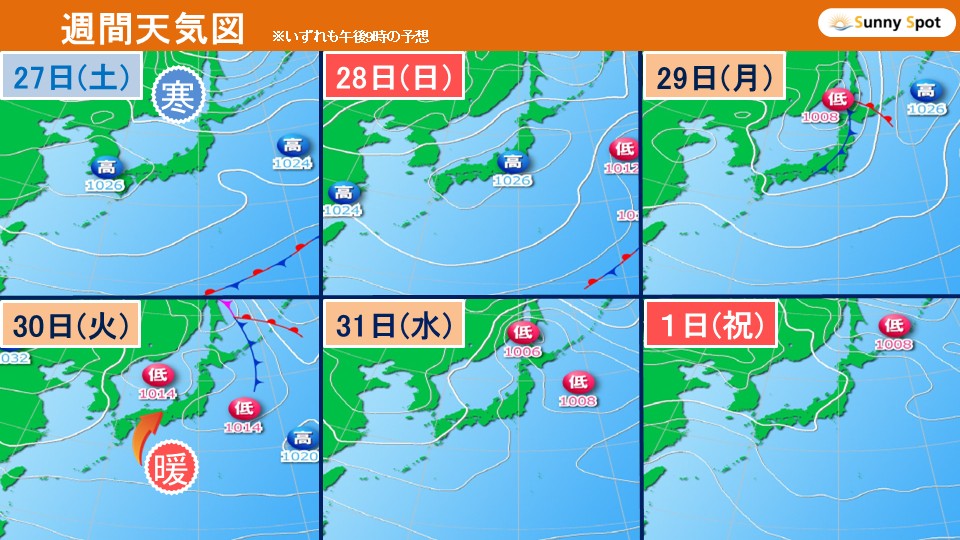
#27th (Sat) - 28th (Sun)#
Many places around Honshu will be covered by a mobile high pressure system, resulting in mild winter skies.
The temperature is expected to be high and it will not be very cold.
It might be a good idea to do your year-end shopping on Saturdays and Sundays.
#29th (Monday) - 31st (Wednesday) New Year's Eve#
Low pressure systems are expected to pass one after another near Hokkaido.
Although there will be snow and rain in many places in northern Japan,
the low pressure system itself will not develop that much, and the area that will experience rough weather is expected to be narrow.
It is expected that there will be very little snow or rain during the time when the New Year's Eve bell rings.
Also, due to the influence of warm air heading toward a low pressure system, temperatures will be higher,
The end of the year is not expected to be as bitterly cold as in previous years.
#January 1st (holiday), New Year's Day#
The current forecast is that New Year's Day 2026 will be gently covered by high pressure, and many places will be relatively sunny.
The first sunrise of the year is likely to be seen in many places, mainly in western and eastern Japan.
(Forecast as of December 25th)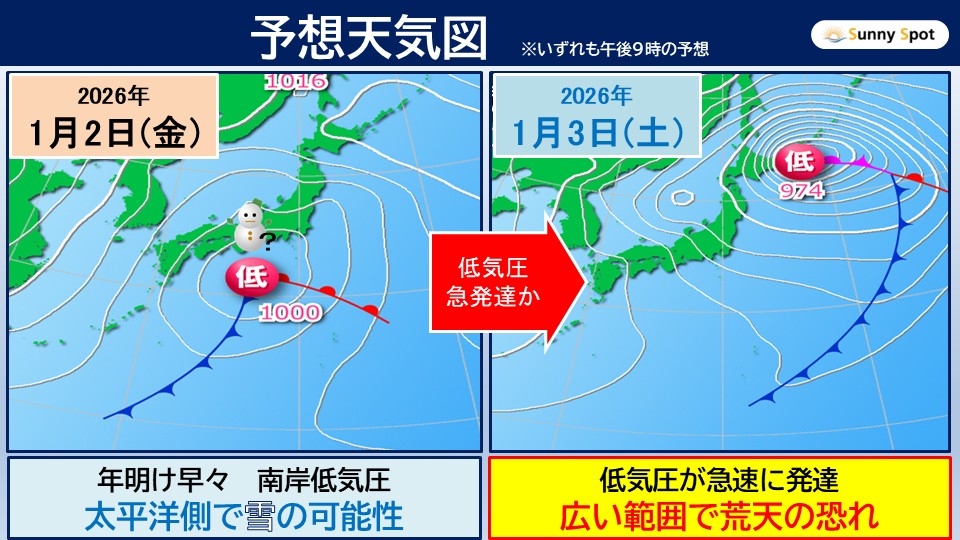
#January 2nd (Friday) - 3rd (Saturday)#
Although there are many places where the weather is relatively calm at the end of the year, stormy weather is expected early in the new year.
On the 2nd (Friday), due to the influence of a low pressure system moving eastward off the southern coast of Honshu,
snow and rain are expected to fall on the Pacific side, where it usually doesn't snow.
Depending on the development of the low pressure system and the strength of the cold air above, there is a possibility of heavy snow that may affect traffic, such as
U turn rush.
In addition, on the 3rd (Saturday), the low pressure system is expected to rapidly develop
and move towards the waters near the Chishima Islands,
with the possibility of heavy snow and strong winds in northern and eastern Japan, resulting in stormy weather.
If the low pressure system develops as predicted,
planes, expressways, trains, etc. may be delayed or canceled around the 2nd (Friday) to 3rd (Saturday) of the new year.
Please continue to pay attention to the latest weather and traffic information.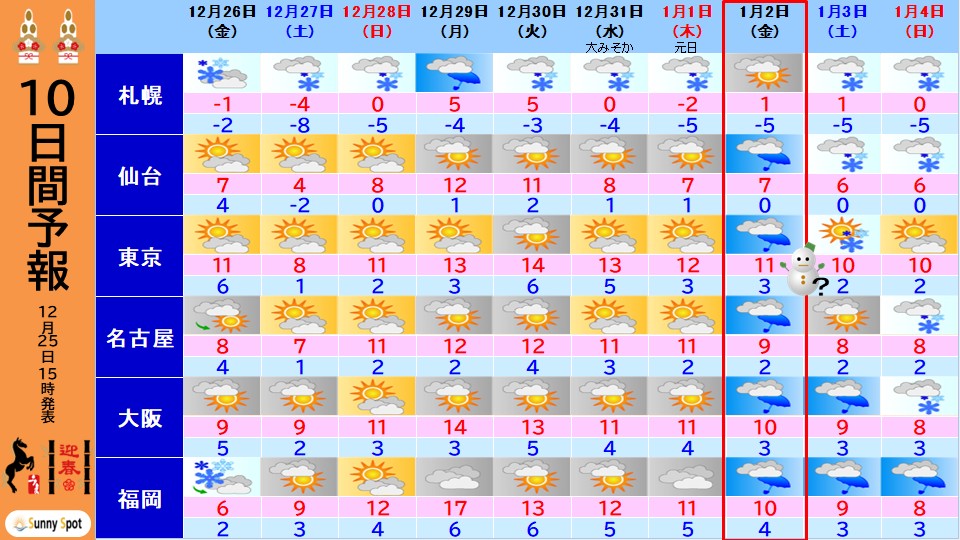
-
Tomorrow, the 26th (Friday), there will be severe weather on the Sea of ??Japan side of northern and eastern Japan. Be on guard for traffic disruptions due to heavy snow.
2025/12/25 08:38
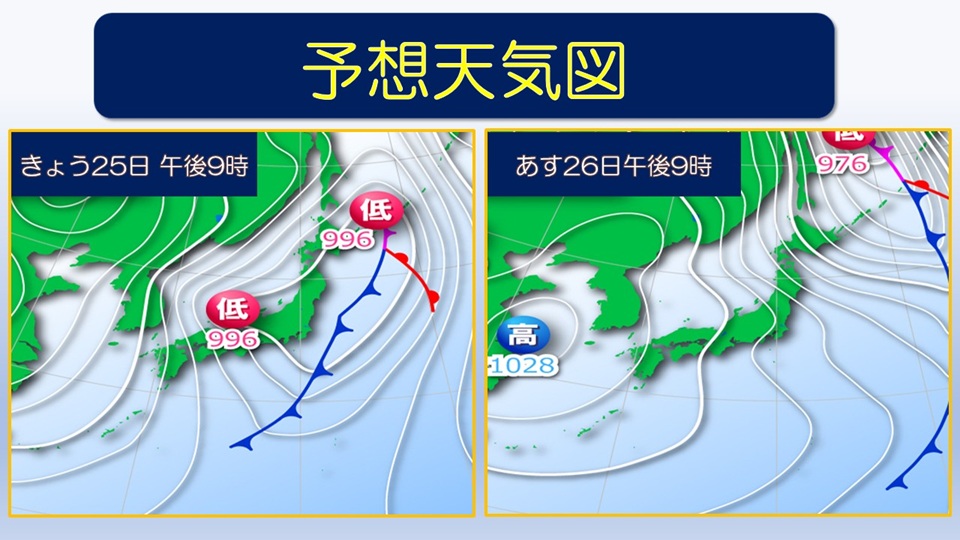
-
Today, the 25th, a low pressure system accompanied by a front is moving north-northeast off the coast of Sanriku, and the area of rain clouds is expanding.
The low pressure system is expected to continue to develop until tomorrow, the 26th (Friday), moving from near Hokkaido to the Sea of Okhotsk. The atmospheric conditions are expected to become extremely unstable as the area around Japan gradually shifts to a strong winter-like atmospheric pressure pattern and strong cold air flows into the upper atmosphere.
Additionally, another low pressure system will form in the western part of the Japan Sea today, the 25th, and will rapidly develop as it moves eastward through the Sea of Japan until tomorrow, the 26th (Friday).
Be wary of traffic disruptions caused by strong winds, blizzards, high waves, and heavy snow from northern Japan to western Japan. Also, be careful of strong gusts of wind such as lightning and tornadoes.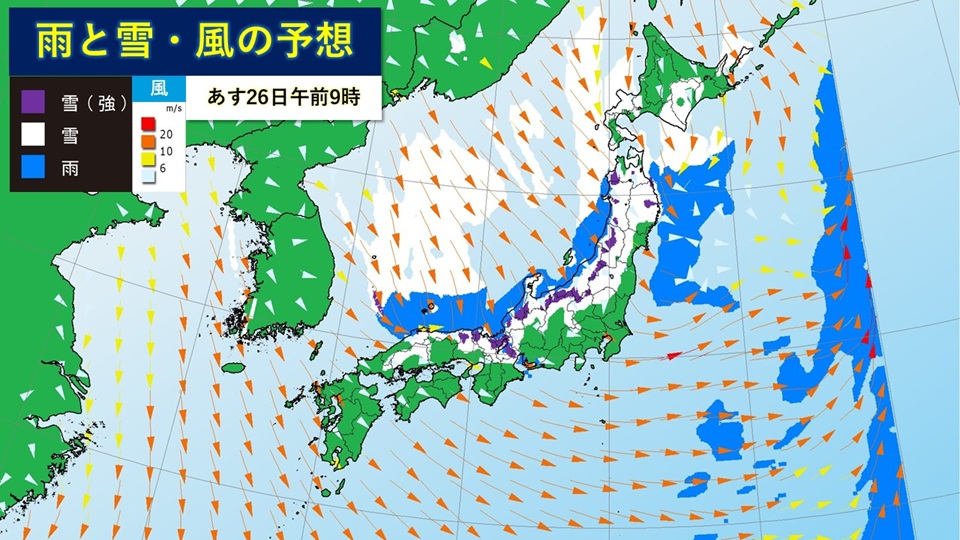
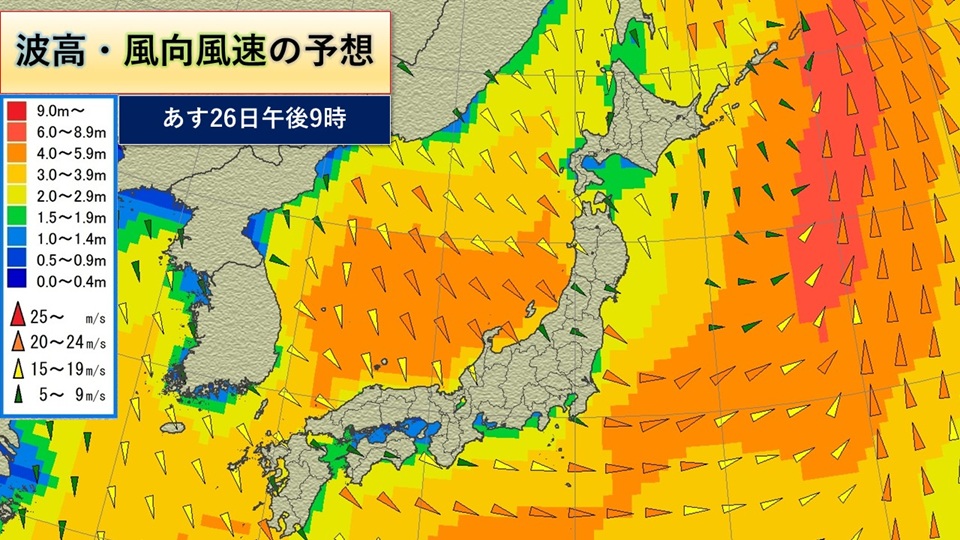
[Wind Forecast]
Due to the winter-like atmospheric pressure distribution and the rapidly developing low pressure system, very strong winds accompanied by snow will blow mainly from northern Japan to the Sea of Japan side of western Japan from tomorrow, the 26th (Friday), causing blizzards in some places. There is a risk that winds will suddenly increase around a low pressure system that is rapidly developing in the Sea of Japan and moving east.
#Expected wind strength
+Maximum wind speed (maximum instantaneous wind speed) expected today on the 25th
Hokuriku region 23 meters (35 meters)
Kinki region 20 meters (30 meters)
Chugoku region 23 meters (35 meters)
+Maximum wind speed (maximum instantaneous wind speed) expected for tomorrow 26th (Friday)
Hokkaido region 20 meters Le (30 meters)
Tohoku region 20 meters (30 meters)
North Land region 25 meters (35 meters)
Kinki region 20 meters (30 meters)
Chugoku Region 23 meters (35 meters)
[Wave Forecast]
On the Japan Sea side of northern and western Japan, there will be heavy waves in some places tomorrow, the 26th (Friday).
#Expected wave height
+Expected wave height for tomorrow 26th (Friday)
Tohoku region 6m
Hokuriku region 6m with undulation
Kinki region 6m With swells
Chugoku region 6m With swells
[Snow forecast]
Due to a strong winter-like atmospheric pressure distribution, there will be heavy snow in some places tomorrow, Friday the 26th, mainly from northern Japan to western Japan on the Sea of Japan side.
#Forecasted amount of snow (in areas with the most)
+24-hour snowfall expected by dawn on the 26th (Friday)
Kinki region 30cm
Chugoku region 25cm
Northern Kyushu region 20cm
Expected 24-hour snowfall amount
Tohoku region 70cm
Kanto-Koshin region 50cm
Hokuriku region Direction 70cm
Tokai region 70cm
Kinki region 40cm
Chugoku region 40cm
-
Today the 25th (Thursday) Widespread rain on Christmas Day; stormy weather warning on the Sea of ??Japan side at night
2025/12/25 06:27
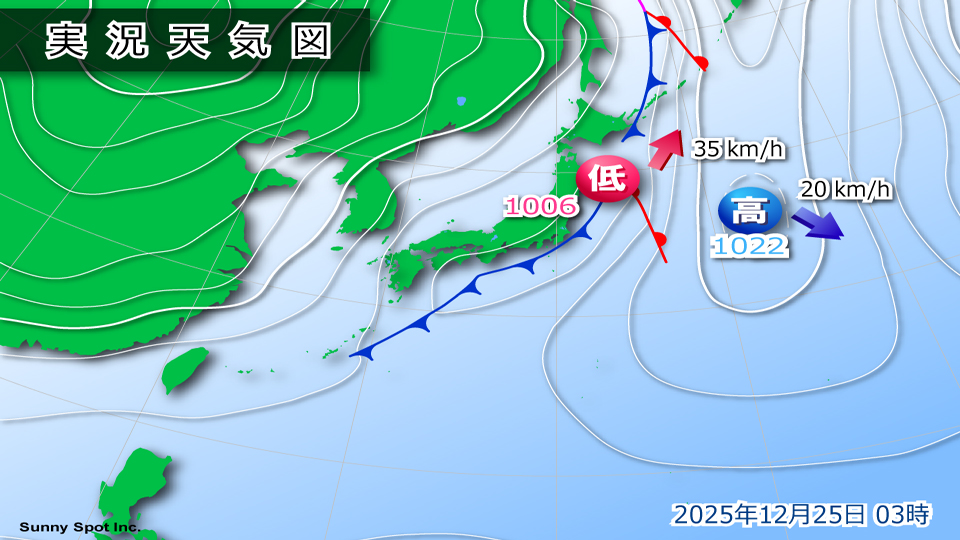
-
Today, the 25th (Thursday) of Christmas, is likely to be a day where umbrellas will be needed widely due to the effects of low pressure and fronts. By night, the atmospheric pressure will shift to a winter-like pattern, so you need to be careful of rough weather on the Sea of Japan side.
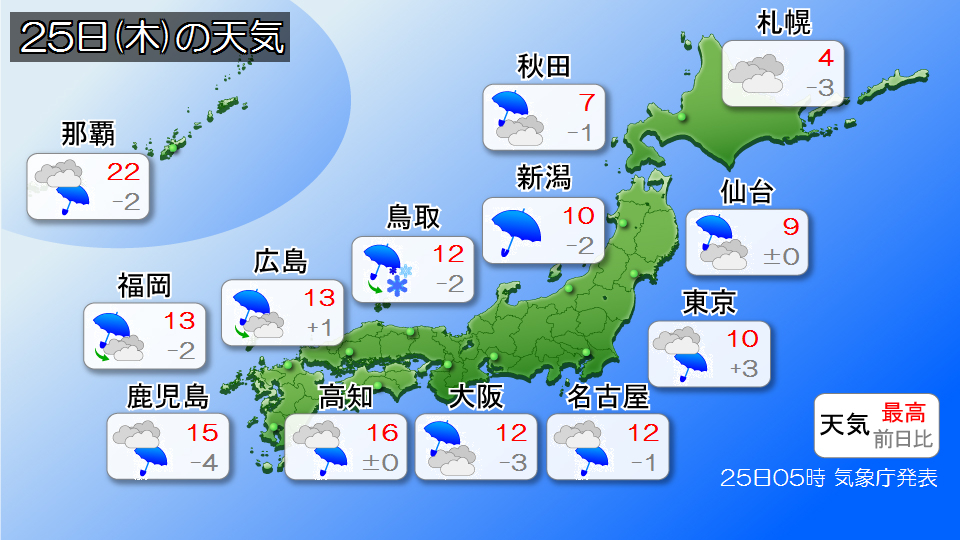
Clouds tend to spread over Hokkaido, and snow and rain will gradually start to fall in some places in the afternoon. Please prepare rain gear when going out.
It will rain in many places from Tohoku to Kyushu in the morning, and it will rain intermittently. It looks like this will be a day when rain gear will come in handy. Please bring rain gear when going out.
On the Pacific side of western Japan, it is expected to stop in many places in the afternoon. Please be careful not to leave your rain gear behind when you return.
As the weather shifts to a winter-like atmospheric pressure pattern toward night, rain and wind are expected to gradually increase on the Sea of Japan side. It's best to go home early, as you'll need to be more careful the later you go.
-
There is a risk of warning-level heavy rain in the southern Kanto region until Christmas morning. Snow in Kyushu and China late at night. Where is the white Christmas
2025/12/24 16:18
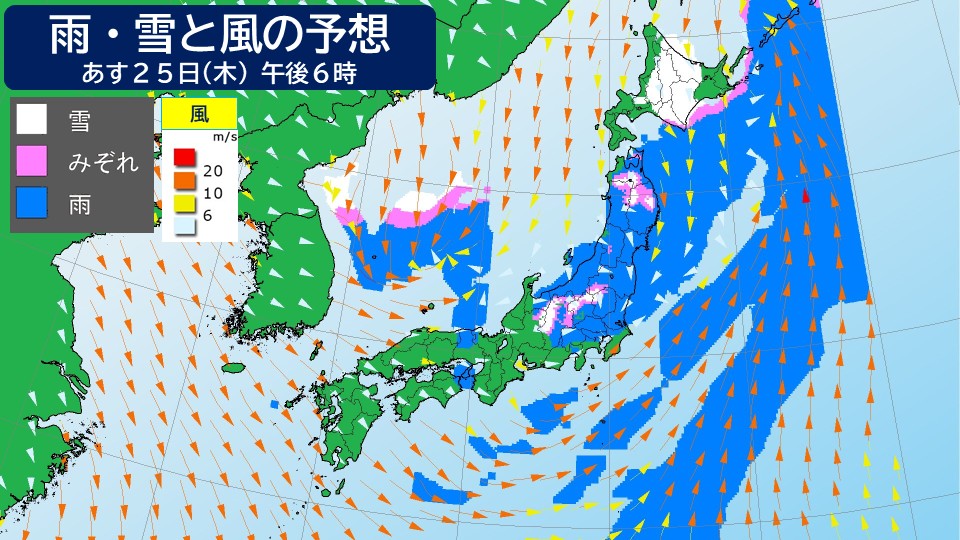
-
A low pressure system and front will pass near Japan tomorrow, December 25th (Thursday) leading up to Christmas.
Warm air for this time of year will flow towards a low pressure system and front, and widespread rain is expected.
There is a risk of warning-level heavy rain in the southern Kanto region into Christmas morning.
Also, the possibility of a white Christmas (snow falling on Christmas Day and the ground covered with snow) is likely to be limited to some areas, mainly in northern Hokkaido.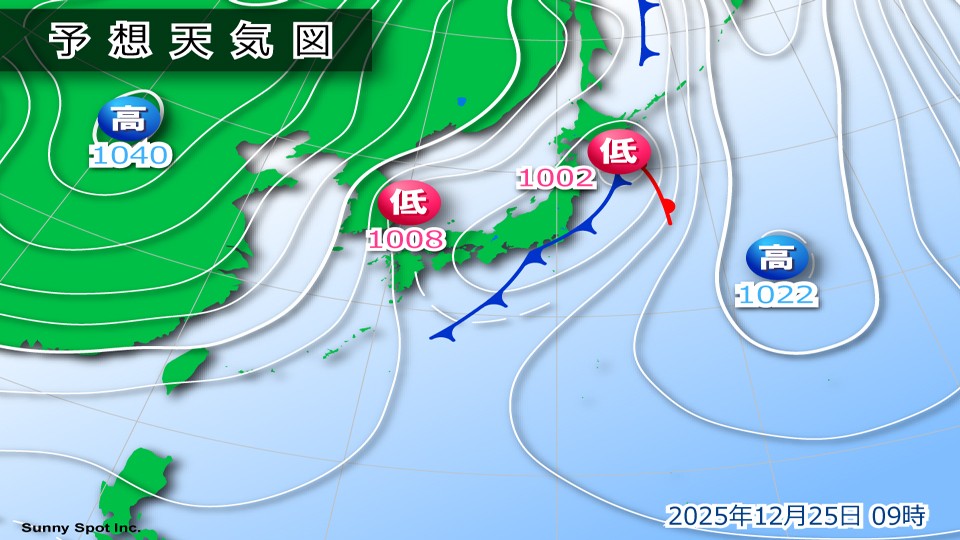
#Heading towards a low pressure system, at an altitude of approximately 1500m, it will be warm and humid and more than 10c higher than normal
A low pressure system with a front off the coast of Sanriku will advance toward the waters near the Chishima Islands from today, the 24th (Wednesday), Christmas Eve to tomorrow, the 25th (Thursday), Christmas.
Also, the low pressure system accompanying the front on the Pacific side of western Japan is expected to move east of the Kanto region and merge with the cold front extending from the low pressure system near the Chishima Islands on Christmas night, the 25th (Thursday).
In response to the cold vortex with cold air in the sky, a low pressure system will form in the western Sea of Japan, and will continue to develop as it moves toward the coast of Noto by Christmas night, the 25th (Thursday).
Warm, humid air that is more than 10 degrees Celsius higher than normal is expected to flow toward these low pressure systems and fronts at an altitude of around 1,500 meters.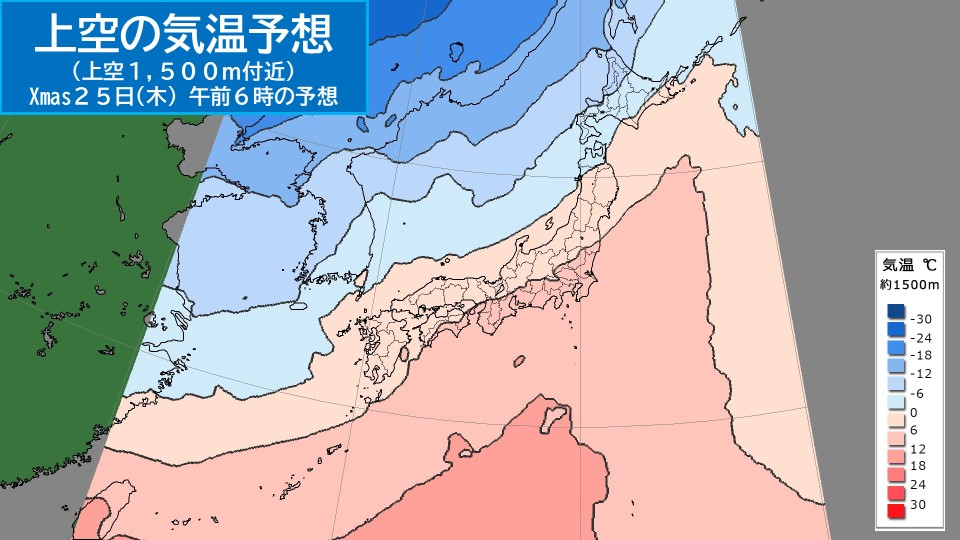
#Towards Christmas morning There is a risk of heavy rain reaching the southern Kanto warning level
Tomorrow, the 25th (Thursday) On Christmas Day, much warmer air will flow in compared to normal years, so there will be many places where it will rain instead of snow.
Also, atmospheric conditions are expected to be unstable.
In the morning, it will rain widely from Okinawa to Tohoku, and there is a risk of warning-level heavy rain in the southern Kanto region.
Also, there will be places along the mountains of Hokuriku where there will be snow.
In Hokkaido, it is expected that there will be snow and rain on the Pacific side and the Sea of Okhotsk, and snow in inland areas.
During the day, there will be some places near the Kanto region where the rain will stop temporarily.
The rain is expected to stop in some places in Kyushu and Shikoku from the evening to the beginning of the night.
In the northern part of the Kanto-Koshin region, there will be places where there will be snow.
At around 1,500m above Hokkaido, there are places where cold air below -6c, the standard for snow on the plains, will flow into the Sea of Japan and Sea of Okhotsk sides, and snow will begin to fall.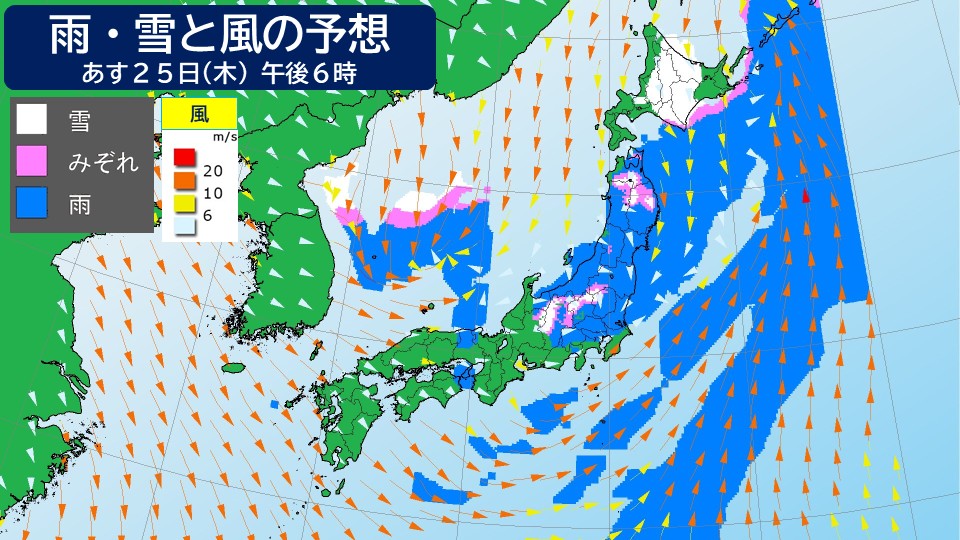
#Late Christmas Night Snow will begin to fall in Kyushu and China.
Late at night, cold air with temperatures below -6 C will flow into western Japan at around 1,500 meters above the ground, where snow is expected to fall on the plains.
It is expected that snow will begin to fall in some places in southern Kyushu, northern Kyushu, and China.
Although it snows on Christmas Day, the ground is not covered with snow, so it cannot be called a white Christmas.
However, on Friday the 26th, snow is expected to accumulate in some places, especially in the mountains, even in southern Kyushu.
Please be prepared for snowfall and frozen roads.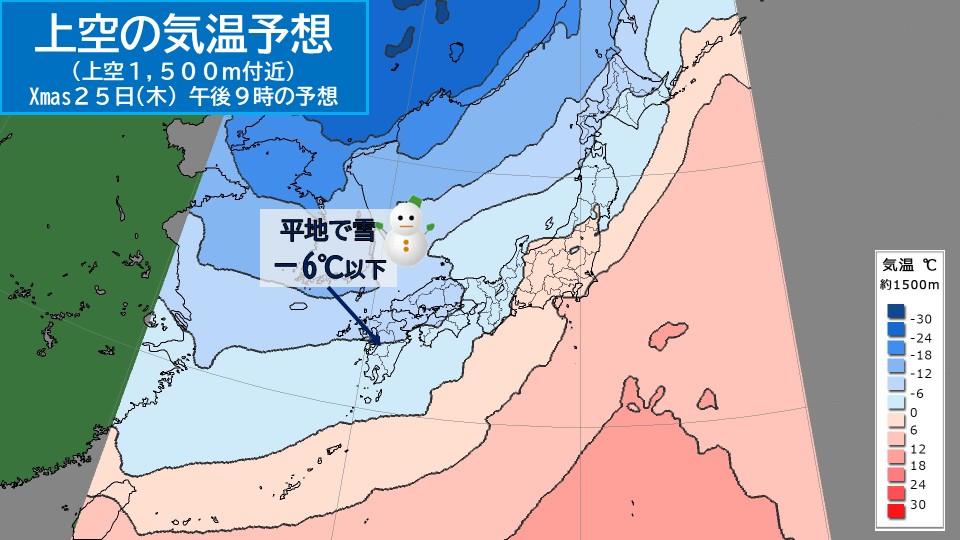
-
Even though the winter-like atmospheric pressure pattern does not continue, the sea surface temperature is "warm in the west and cold in the north" [Ocean summary (December 14-20, 2025)]
2025/12/24 13:18
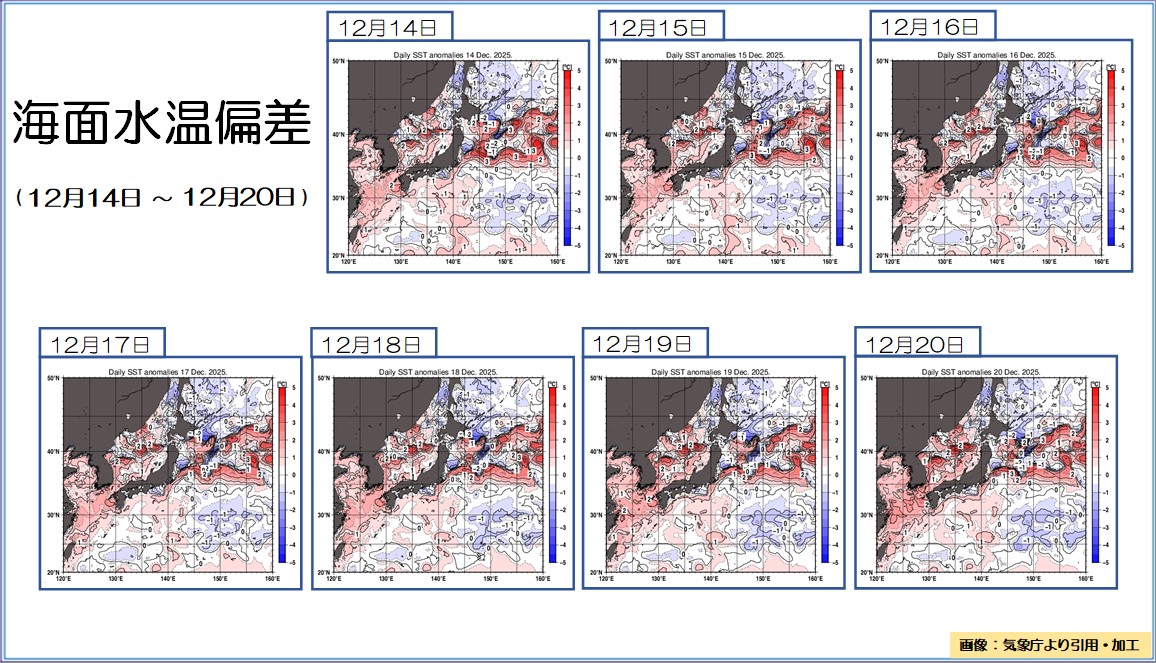
-
This winter is expected to be a ``warm'' winter, and there will be fewer days with winter-like atmospheric pressure around Japan from December 14th to 20th.
Covered by a mobile high pressure system, there are fewer snowy days on the Sea of Japan side compared to previous years.
Looking at sea surface temperatures,
While there are many places in the Sea of Japan and the East China Sea that are at or above normal,
off the coast of Sanriku, near the Kuril Islands, and in the Sea of Okhotsk, there are many places that are at or below normal.
Sea surface temperatures are ``westernly warm and northernly cool.''
Below is the ocean summary (December 14th to 20th, 2025).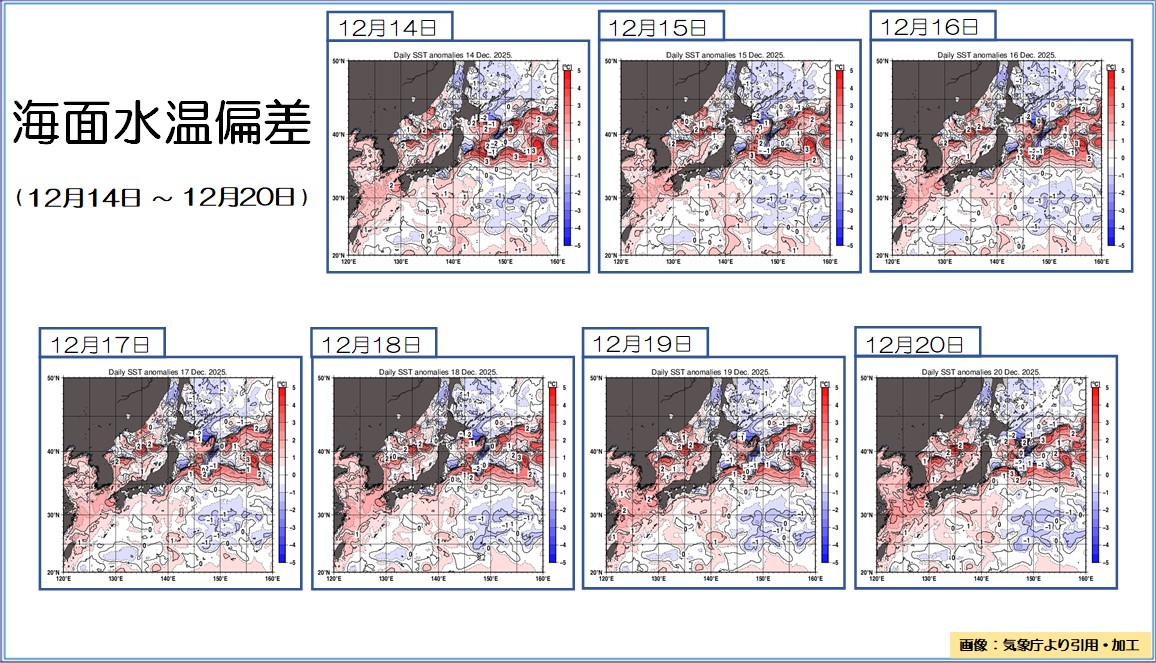
#Pressure distribution and waves
On the 14th, there were low pressure systems in the Sea of Japan and the southern coast of Honshu, both of which were developing as they moved northeast.
A barge with a wave height of 4m in the East China Sea and the eastern Kanto region.
On the 15th, the winter-like atmospheric pressure pattern strengthened.
The wave height was 6m and it became a huge storm off the southeastern coast of Hokkaido.
On the 16th, a mobile anticyclone came from the west, and
waves gradually became calmer.
On the 17th, due to the influence of a stagnant low pressure near the Sea of Okhotsk,
Sea of Okhotsk continued to be flooded with wave heights of 4m.
From the 18th to the 19th, waves around Japan remained calm, covered by a mobile anticyclone.
On the 20th, the center of the high pressure system moved east of Japan.
Waves rose to 3m in height off the coast of the Tokai region, where southerly winds from the edge of the high pressure system blow.
#Sea surface temperature
Sea surface temperatures in the Japanese waters continue to be lower than normal west of Hokkaido.
The temperature in the central and western parts of the Sea of Japan was higher than normal or significantly higher, with a maximum of 4 C above normal.
In the East China Sea, areas that are slightly higher than normal are expanding.
Sea areas south of Japan continued to be at normal levels, but waters off the coast of the Tokai Sea and the Boso Peninsula continued to be below normal levels.
The waters off Sanriku continue to be at or slightly below normal.
Off the southeastern coast of Hokkaido, sea areas that are lower than normal are expanding.
The Sea of Okhotsk continued to be at normal levels.
-
Warning-level heavy rain in the Kanto region on Christmas, followed by "intense cold" and warning-level heavy snow, affecting traffic [Weekly weather]
2025/12/24 12:09
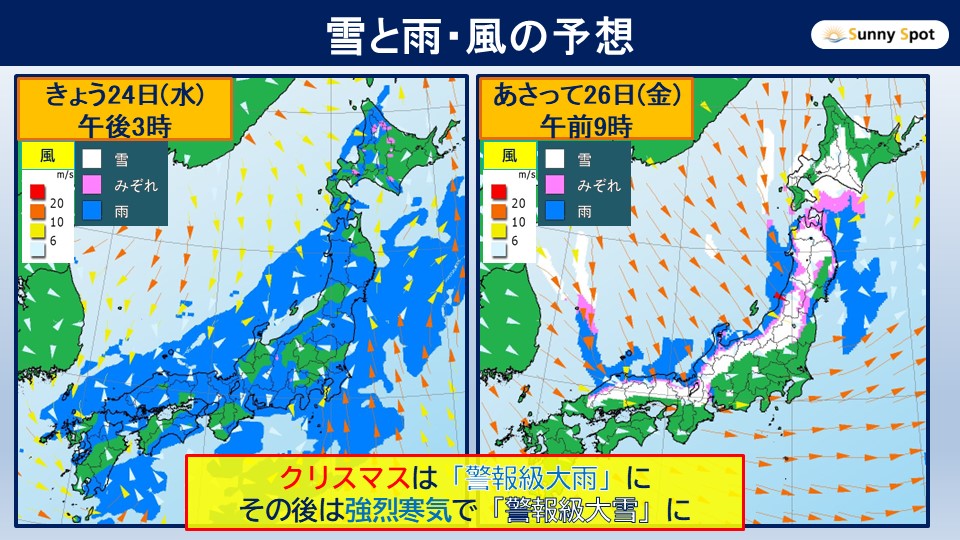
-
Today, the 24th (Wednesday), Christmas Eve, it is raining nationwide due to the passage of a
low pressure system and front.
A low-pressure system is expected to develop towards the east of Japan over the next Thursday, the 25th (Thursday) and Christmas,
and another low-pressure system is expected to pass from the Sea of Japan to the Tohoku region.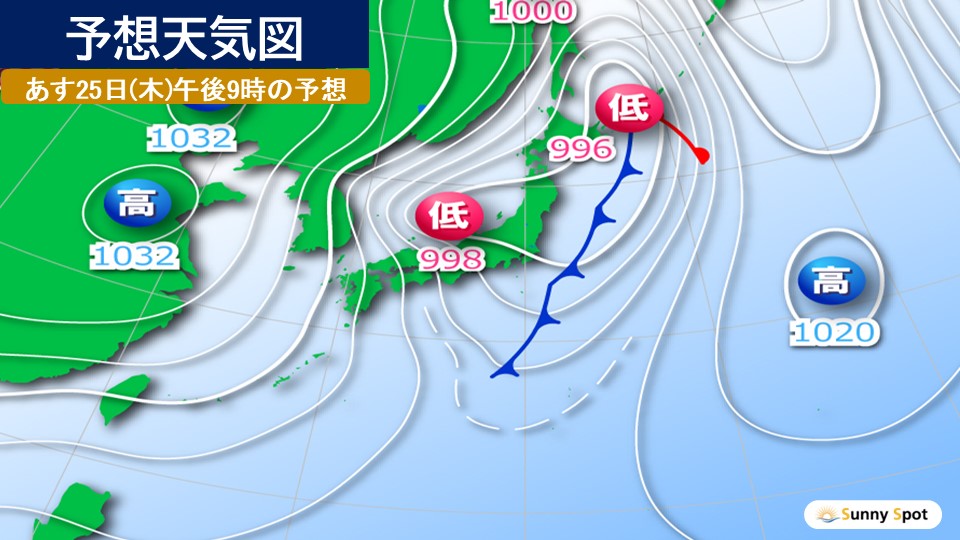
Due to the influence of warm and humid air heading towards a low pressure system, it is likely that there will be warning-level heavy rain in places such as the Kanto region into tomorrow.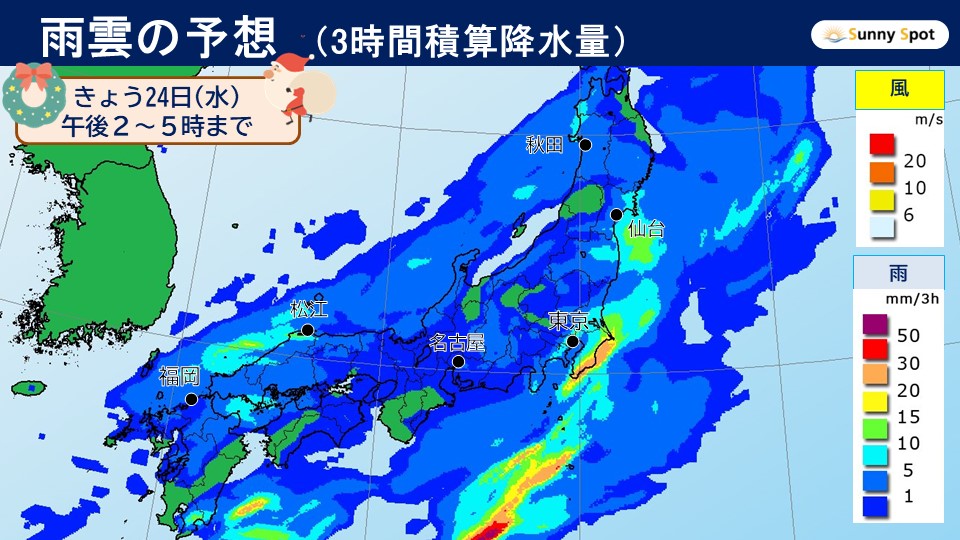
Looking at the cumulative precipitation for the three hours up to 5pm today, the 24th (Wednesday),
there are widespread rain clouds around Honshu,
especially in Chiba Prefecture, where there is a risk of heavy rain as the area is shown in orange.
In areas such as Chiba Prefecture and the Izu Islands, there are places where
heavy rain with thunderstorms will fall from evening to night, and
heavy rain warnings may be issued.
Furthermore, the next low pressure system will form near Honshu tomorrow, the 25th (Thursday), so it is expected to rain over a wide area tomorrow morning.
There is a risk of heavy rain again in Kyushu, Chugoku, and the Tokai region.
There will be widespread rain from Christmas Eve to Christmas, with the possibility of heavy rain in some areas.
Please take precautions against rain when going out.
After this rain, the strongest cold air of the season will flow in westward.
Looking at the cold air forecast at 9 a.m. on Friday the 26th, the coldest air of the season is expected to flow westward.
Cold air of -6 degrees Celsius or lower (the standard for snow on flat land) at around 1500 meters above the ground is expected to flow from western Japan and the Tokai region to Hokuriku and the Sea of Japan side of northern Japan.
Furthermore, even stronger cold air, below -12c, is expected to flow into Kyushu and the Chugoku/Shikoku region.
The coldest temperature so far this season (cold air flowed in) was on December 4th (Thursday), when it was -7.2c at 1500m above Fukuoka.
This time, the temperature is expected to be about 5 degrees Celsius lower than the previous strong cold, and the cold that starts on the 26th (Friday) can be said to be the ``strongest cold of the season.''
Looking at the forecast for snow, rain, and wind at 9 a.m. on the 26th (Friday) the next day, there will be widespread snow and rain from the Sanin area to the northern Sea of Japan side.
There are likely to be warning-level heavy snowfall in some places, especially in Hokuriku.
In addition, snow clouds will move into southern Kyoto and Mie prefectures on the Pacific side, and
snow will also fall on the flatlands of western Japan.
Let's take a look at the weekly weather to see how long this season's strongest cold air will last.
There will be rain in many places in Tohoku until the 25th (Thursday), but from
26th (Friday) there will be snow in many places in northern Japan and Hokuriku.
Please be aware of poor visibility due to heavy snow or blizzard.
Also, traffic may be affected, so
Please check the latest weather and traffic information when you return to your hometown or other outings.
On the 27th (Saturday), the lowest temperature in Sapporo will be -7c, and the highest temperature will be -3c,
It will be a "midwinter day" with negative temperatures throughout the day.
Even in sunny Tokyo, it will be as cold as 9 degrees Celsius, a mid-winter cold.
After the 28th (Sunday), the cold air will gradually disappear, and
the temperature is expected to finally return to the temperature typical of this time of year.
-
A rainy Christmas nationwide, followed by strong cold air and winter-like atmospheric pressure on the 26th
2025/12/24 10:19

-
There is a high pressure system over the sea east of Japan, and it is moving away to the east.
On the other hand, there is a low pressure system accompanied by a front in the northeastern region of China and the Sea of Japan, and there is also a low pressure system in the East China Sea, both of which are moving northeast.
Currently, there are places where it is snowing and raining in Hokkaido and northern Tohoku, rain and snow from southern Tohoku to Koshin, and rain from Kinki to Okinawa.
Today, the 24th (Wednesday), a low pressure system and a front will approach from the west, resulting in poor weather across the country. It looks like it will be a rainy Christmas in many places this year.
There are some places in Okinawa where it will rain in the morning, but it is expected to gradually increase.
It is expected to rain and snow in Hokkaido, with intermittent rain continuing from Kyushu to Tohoku, and heavy rain with thunder in some places.
Please be careful.
The maximum temperature will be around average or slightly higher in many places, but the Kanto region is likely to experience mid-winter temperatures.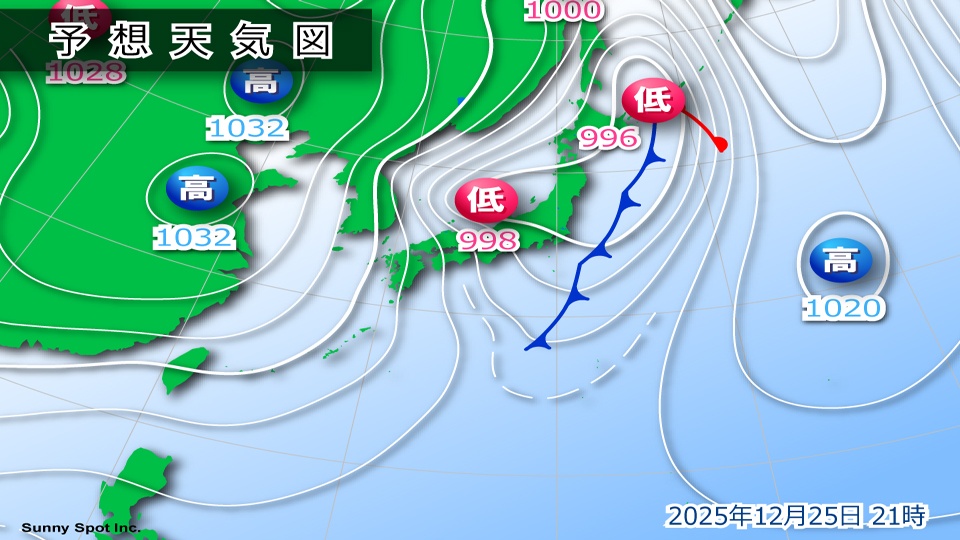
Tomorrow, the 25th (Thursday), there will be a trough of atmospheric pressure near Japan, with rain over a wide area, and snow and rain in Hokkaido.
The highest and lowest temperatures will likely be at or above normal in many places.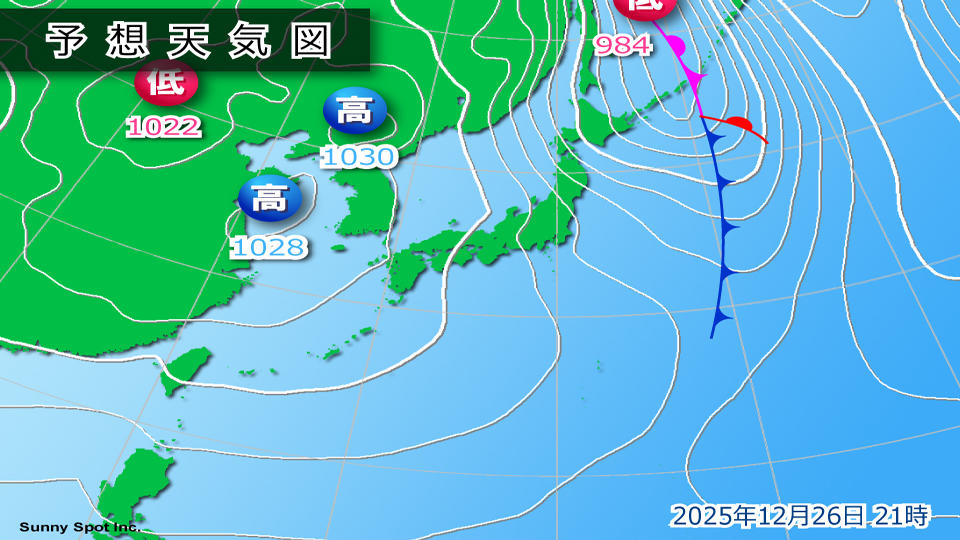
On the 26th (Friday), a winter-type pressure distribution will occur with a successful east low.
A strong cold air is moving south, and the temperature will drop significantly in many places.
There is a risk of snow falling from Hokkaido to the San'in region on the Sea of Japan side, and there is a risk of heavy snow or blizzard, so please pay attention to future information.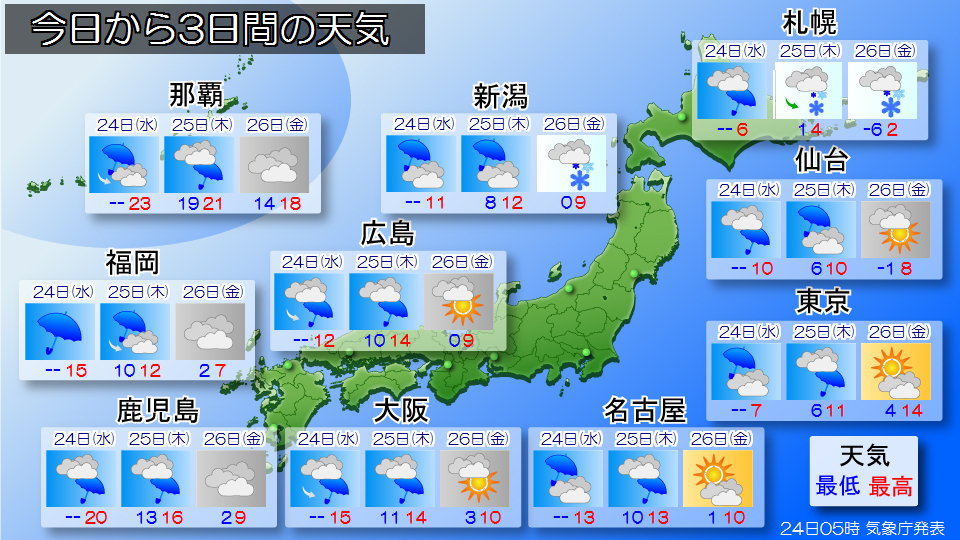

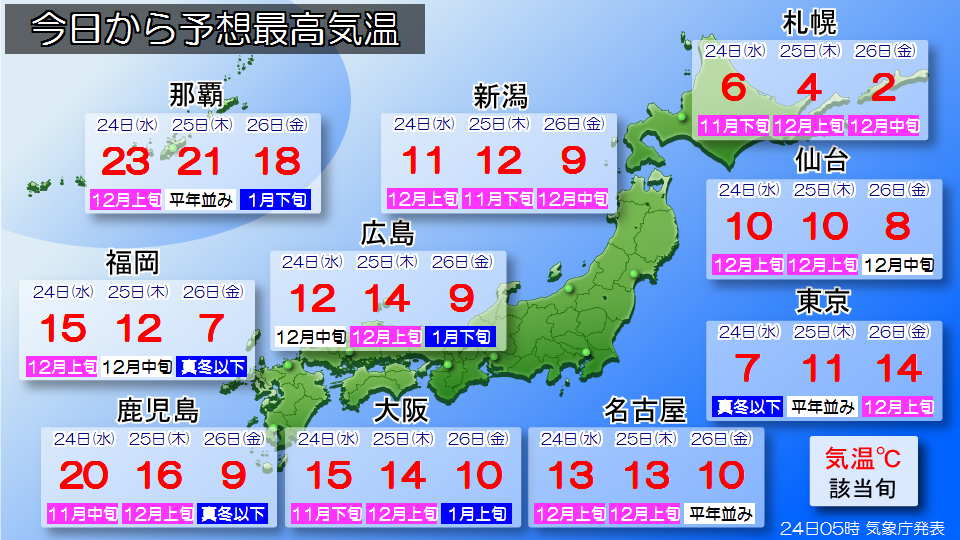
-
[3-month forecast] Dry air on the Pacific side of eastern and western Japan. Be careful when handling fire. Northern Japan will be hotter than normal in March. Be careful of damage from melting snow.
2025/12/23 16:51

-
Today, the 23rd (Tuesday), the Japan Meteorological Agency announced the weather forecast for the next three months (January to March).
Temperatures over the next three months will be at or above normal in northern Japan, as they will not be affected by cold air.
In particular, the temperature in March next year is likely to be higher than normal in northern Japan, and the footsteps of spring are likely to be felt earlier than normal, but we need to be careful about the damage caused by snowmelt.
Precipitation over the next three months will be less affected by low pressure, so it will be low on the Pacific side of eastern and western Japan and Okinawa and Amami, and will be at or below normal on the Sea of Japan side of western Japan.
Although it is originally a dry period mainly on the Pacific side, there is a possibility that precipitation in January and February next year will be lower than normal on the Pacific side of eastern and western Japan.
This is the season when forest fires occur frequently, so please be careful when handling fire.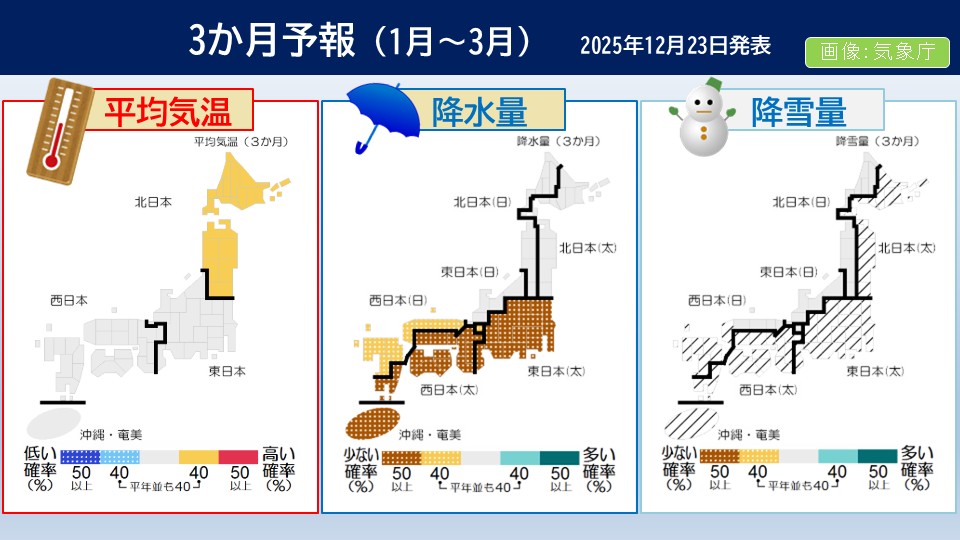
Expected characteristics of the ocean and atmosphere
Sea surface temperatures in the equatorial Pacific Ocean will gradually disappear from low conditions in the central and eastern regions, but will remain high in the western regions.
Meanwhile, sea surface temperatures are expected to remain low in the Indian Ocean.
For this reason, cumulonimbus clouds are likely to occur from Indonesia to the vicinity of the Philippines.
As a result of these effects, upper-level westerly winds are expected to meander northward over eastern Eurasia and southward near Japan, but are expected to flow at generally normal positions.
The Siberian High is weak on the northeast side, and there will be periods when its overhang to the southeast is somewhat strong.
From these facts, it is expected that there will be a period when the northerly seasonal winds will be strong toward the Philippines, and the winter-like pressure pattern will be strong in western Japan, Okinawa, and Amami.
The Pacific side of eastern Japan, western Japan, and Okinawa/Amami will be less susceptible to the effects of low pressure.
On the other hand, the winter-like atmospheric pressure pattern will not last long, especially in northern Japan, so it is unlikely to be affected by cold air.
However, there is a possibility that cold air will temporarily flow into northern Japan, causing heavy snowfall that will rapidly increase snowfall in a short period of time, especially along the Sea of Japan side.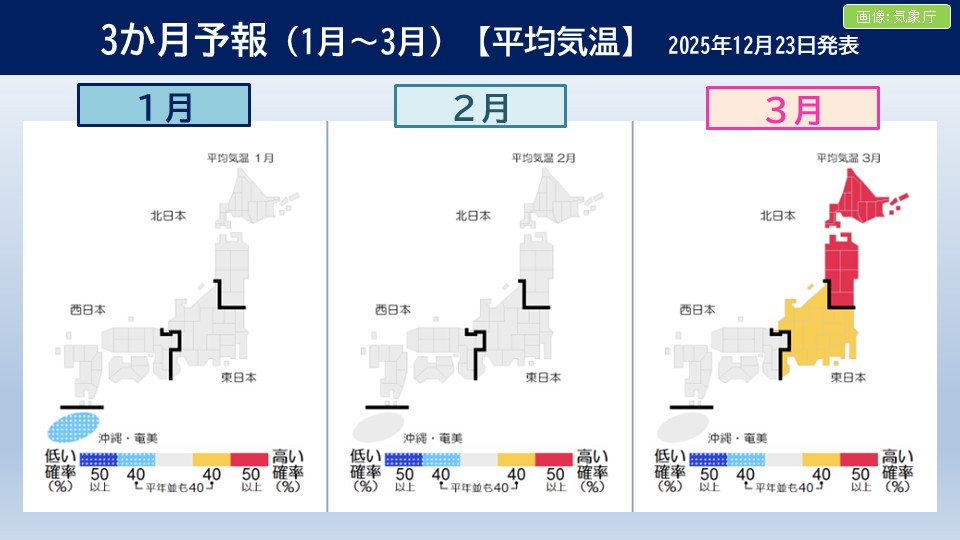
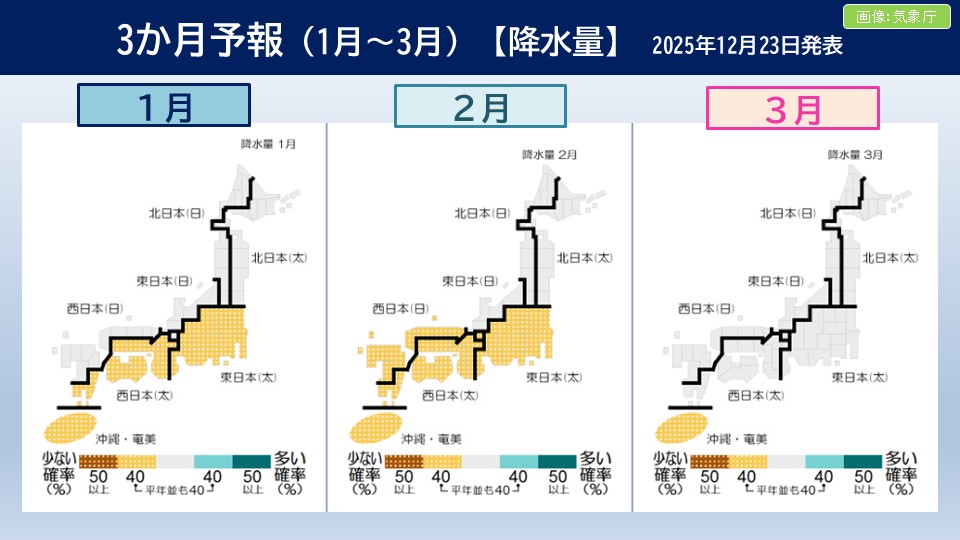
#January
The Pacific side of eastern and western Japan is less affected by low pressure, so there will be more sunny days than normal.
The average temperature in Okinawa and Amami is expected to be at or below normal.
Precipitation will be at or below normal on the Pacific side of eastern and western Japan, Okinawa and Amami.
#February
As it is less affected by low pressure, the Pacific side of eastern and western Japan is expected to have more sunny days than normal, while the Sea of Japan side of western Japan is expected to have fewer cloudy, snowy, or rainy days than normal.
Average temperatures will be near normal throughout the country, and precipitation will be near normal or below normal in the Pacific side of eastern Japan, western Japan, and Okinawa/Amami.
#March
In eastern and western Japan, Okinawa and Amami, the weather is expected to change every few days.
The average temperature will be higher than normal in northern Japan, and at or above normal in eastern Japan.
Precipitation is expected to be at or below normal in Okinawa and Amami.
-
[Forecast of 7c tomorrow in Tokyo] A change from the original forecast - severe cold and cold rain on Christmas Eve
2025/12/23 13:03

-
Today, the 23rd (Tuesday), is covered by high pressure, and many places are experiencing mild winter skies.
However, at night, the center of the high pressure will move away to the east of Japan,
humid air will flow in from the south,
and there will be places in the Kinki and Kyushu regions where it will start to rain.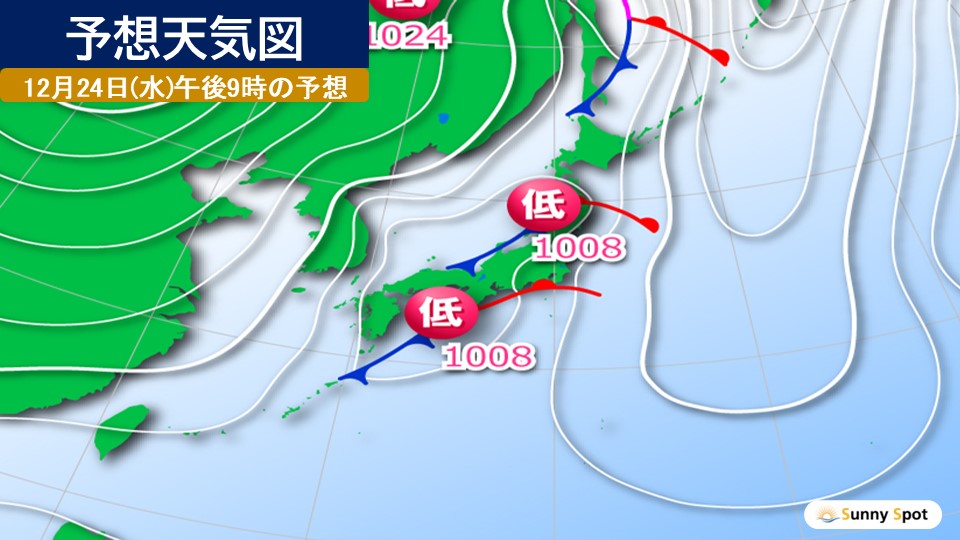
Looking at the forecast weather map for the night of tomorrow, the 24th (Wednesday),
two low pressure systems are expected to pass across Honshu.
As a result, it will rain across the country tomorrow, the 24th (Wednesday).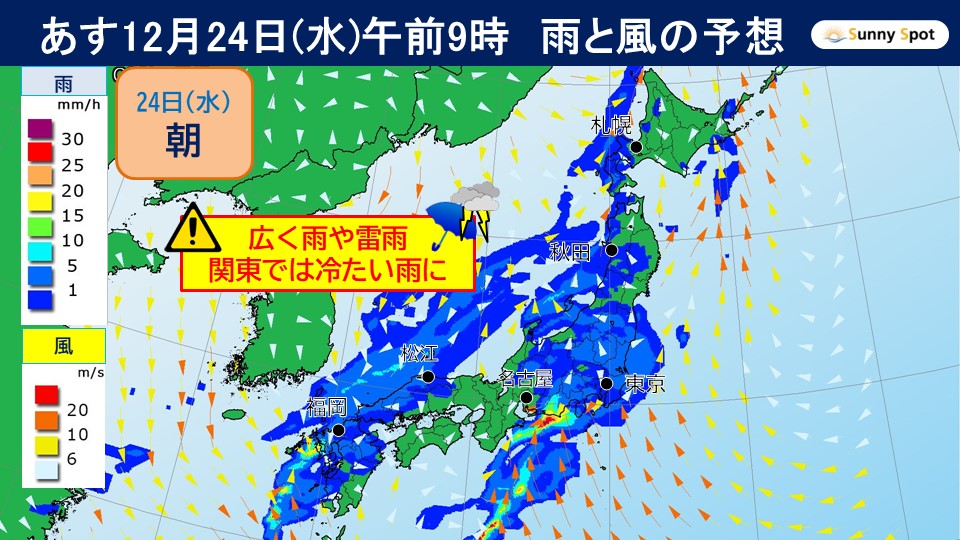
The influence of warm, humid air flowing towards the low pressure system and front will make the atmospheric condition unstable, and heavy rain with thunder is likely to occur in some places in Kyushu into the morning of the 24th (Wednesday),
in the southern Kinki and Tokai regions after the evening.
There will be rain and thunderstorms in the Kanto region from dawn and in the Tohoku region from noon, and there is a possibility that the rain will become stronger.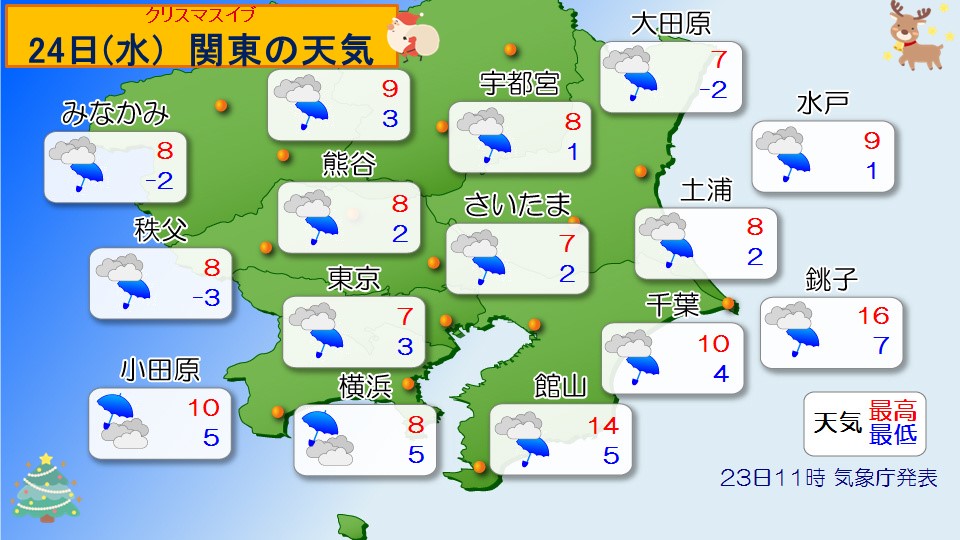
The initial forecast was for a strong flow of warm air toward a low pressure system,
As of yesterday, the predicted maximum temperature in Tokyo on Wednesday the 24th was 12c.
However, today it is forecast that northerly winds will strengthen towards the low-pressure system moving along the southern coast of Honshu,
and the forecast has changed to the forecast that temperatures will drop significantly, especially near the Kanto region.
It is expected to be as cold as mid-winter at 7c in places like Tokyo and Saitama, and 8c in places like Yokohama and Utsunomiya.
Initially, it was predicted that it would be a warm Christmas in the Kanto region, but
the forecast has drastically changed to severe cold and freezing rain.
Please be careful not to get sick due to changes in temperature.
A fairly strong cold air
(the strongest cold air this season over western Japan) is expected to flow westward around the 26th and 27th.
The long-term forecast predicted a ``warm winter'' this year, but
sometimes strong cold air will flow in and the daily temperature difference will be quite large.
As forecasts may change significantly in the future,
Please check the latest weather information.







